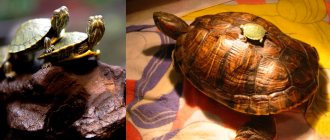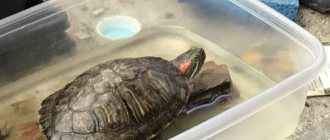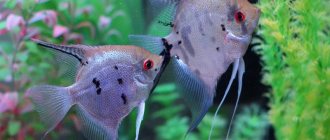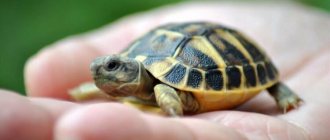The poor birth rate of this species of reptile is also explained by the incompetence of the owners regarding how red-eared turtles reproduce and the inability to create suitable conditions for this.
Determination of gender
To ensure reptiles reproduce at home, it is necessary to find out which sex each turtle belongs to. Obviously, the offspring is the result of the mating of a male and a female.
This is interesting: A female reptile can lay eggs without the participation of a male, but storing them will not give any results, since fertilization in this case was not carried out.
Sexual dimorphism in red-eared turtles appears at one year of age. For comparison, it is recommended to take reptiles of the same age. The distinction between individuals is carried out according to the following criteria:
- body size (females are larger);
- claws on the front paws (in males they are longer);
- tail (longer in males than in females);
- the shape of the lower part of the shell (in females it is flat, in boys it is concave).
Mating process in nature
First of all, it should be clarified that the genital organs of turtles are located in the tail. Therefore, the male approaches the chosen one from behind and crawls onto her back with the front part of his body. He adapts his tail under hers, directing the sexual organ to the right place.
At the end of the action, the male emits a “victory cry”. And let only his chosen one hear it, but this is the song of a winner who has achieved his goal. The female also responds to him with a “yelp.” This is how turtles mate in nature.
Conditions for mating
Reproduction of the red-eared turtle is possible subject to the optimal age for mating - individuals must be young, but at the same time have reached sexual maturity. The readiness of females to reproduce is observed at the age of five, males begin to give birth to offspring in the fifth year of life. If you keep more than two turtles at the same time, it is advisable that there is only one male among them, otherwise the males will fight for the opportunity to mate, causing injury to each other.
Pond slider
Breeding problems
Any turtle breeder faces breeding problems. The most common mistakes are:
unfertilized eggs. In the absence of males, turtles lay “empty” eggs. Only after copulation does conception and successful laying occur;
failure to maintain humidity and correct air temperature in the terrarium;
the absence of mating games negatively affects the interest of males in young females. The partner must win the female, become the winner and receive the desired prize;
a poor diet and lack of vitamins also negatively affect the offspring.
Preparation
Getting red-eared turtles to breed in captivity is quite a difficult task. To achieve the desired result, you first need to take care of your pets’ diet. Reptile food should include vitamins and nutrients. Vitamin E is especially useful for males, as it has a positive effect on the reproductive function of animals. Calcium and phosphorus are useful for the normal course of pregnancy in females.
Before the intended mating, two turtles need to be placed in different aquariums. To create a suitable environment, it is recommended to change the water and heat it to 25 ° C. It happens that during the mating process, the male does not allow the female to come to the surface for a long time. To prevent the reptile from suffocating, the water level in the aquarium should not exceed 10 centimeters. A container with sand must be placed inside the vessel, where the female will lay eggs.
It should be located in a dry area that is easily accessible to the turtle. Please note that mating will only occur if there is soil in the aquarium. A sign indicating that the female is ready to reproduce is the reptile displaying high activity, as well as its refusal to eat.
Brief description of the order of turtles
These animals belong to the order of reptiles. They live in captivity up to 50 years. But in the natural environment they can exist about twice as many. Although there are legends that there are individuals that have reached 350 years or more. But only the lifespan of the Madagascan radiant tortoise Tui Malila is documented - 188 years. Today she is considered a long-living winner.
A distinctive feature of all types of turtles is the presence of a shell. Perhaps, thanks to him, they managed to survive, despite various disasters that occurred on our planet. After all, these creatures are very ancient.
How do turtles mate?
Large and beautiful terrarium for turtles
Home maintenance does not imply that the breeding season depends on the changing seasons of the year, so reptiles can mate at any time. According to general observations, turtles are most active from February to May. Thus, the process of mating pets is best carried out at this time.
Until the moment of copulation, reptiles engage in mating games, which can last for several days in a row. During this period, the most important thing is to create the most comfortable conditions for the animals, ensuring them complete peace. Reptiles should not be disturbed by extraneous noise, vibration or bright light. Also, you should not pick up your pets during this time.
The process of mating games is that the male touches the female’s head with his claws and brings his shell into contact with the female’s plastron. The copulation time of reptiles is no more than five minutes. Then eggs are laid.
Mating games
Turtles are no strangers to demonstrative displays of affection. Males become very active during the mating season. Many people make the mistake of considering turtles to be silent creatures. After all, males, when courting their darlings, often make sounds similar to yapping. And females have the right to express their opinion with their voice.
Usually males challenge rivals to fights. And during the period of “fighting”, weak animals can be injured and die. So it would be a huge mistake to consider turtles as calm and good-natured animals.
The male is not so loyal to his chosen one either. Seeing a female, it begins to shake its head up and down. But he does not intend to wait for her to reciprocate her feelings. Having performed a ritual dance of recognition, the male runs to the turtle and hits it hard with his head in the shell. In addition, he bites the reptile's paws until it is eventually subdued.
Caring for eggs and young
In one clutch the female leaves from 6 to 10 eggs. The diameter of each is 4 cm. The container in which the masonry is located is emptied. The eggs are very carefully transferred to the incubator without turning them over. The temperature in it should be in the region of 25-30 oC. Instead of an incubator, you can use a regular jar of sand, which should be placed next to the heating system to create optimal temperature conditions.
The period of development of the young inside the egg is 2-5 months. All this time it is necessary to maintain the established temperature indicators. As soon as the turtles are born, place them in a separate aquarium where they will be kept for a year.
Keeping turtles at home
There are actually three options for keeping turtles:
- Free, just walking around the apartment.
- In a terrarium.
- In specially equipped enclosures.
You should choose depending on what type of turtle you are going to purchase. That is, in other words, you should find out in the store when purchasing where this species lives in nature, what they like most.
Cleaning up after a turtle is actually even easier than cleaning up after a cat, which is why there will be no difficulties in maintaining and caring for it. You should feed her only in one specific place, and not just anywhere, she must get used to it. Over time, the animal will get used to it and will come to this place when it wants to eat.
When the heating in the apartment is turned off and it becomes cool, you need to put the turtle in some kind of box at night, it will be warmer. Many species of these animals, when they freeze, become lethargic and sick, and may even die.
When cleaning the aquarium, be sure to turn off the heater, otherwise it may break, then after cleaning it must be turned on again. In order to control the temperature, it is necessary to install special thermometers, or best of all, two. Mercury thermometers cannot be used, as they are very harmful.
Age and selection characteristics of turtles
- Sexual maturity in turtles depends on their size. In captivity, pets have constant access to good food, so they often grow faster than their wild counterparts. In the wild, turtles may not be sexually mature or capable of producing fertilized eggs until they are 15 to 20 years old. In captivity, sexual maturity can be reached at approximately 4 - 5 years. Breeding such young turtles in captivity will certainly affect the health of the female, so breeding should be delayed until the turtle is older.
- Males often prefer larger females, so it is important to keep females of the same size in the same breeding group.
- Elderly turtles should also not be forced to mate, as their offspring may have a lot of genetic defects, and there is also a high risk of obstetric complications during laying.
Mineral and vitamin supplements
The diet of turtles requires supplementation with minerals and vitamins. In particular, the female needs additional food supplements throughout the entire period before mating and during egg laying. This is important because it will consume large reserves of calcium to form the calcareous shells of the eggs. She also needs to supply the yolk with nutrients for the developing embryo.
To ensure that the female can produce healthy offspring, give her daily calcium carbonate in the form of limestone flour, pouring it separately from food, and special vitamins, for example, nutrobal or vionate (3 times a week).
Incubation of turtle eggs
Turtle incubator diagram
While in captivity, turtles are able to lay eggs at any time of the year. For mating to occur, several males are needed to compete for the female's attention. One male will not show interest in a female. After mating, females need vitamins E and D, as well as large amounts of calcium. The female can also lay unfertilized eggs. But if you know for sure that you have both males and females, and they had the mating process, then you can try to incubate such eggs.
Turtles can also lay eggs on the floor, but it is better to build a special box for this purpose. It is important that the female is able to dig a hole in it. The substrate that is characteristic of the wild habitat of this turtle is placed in the box. This is sand or a mixture of sand, peat and sphagnum, which must be moist. The laid eggs must be quickly transferred to the incubator. It is important not to turn the eggs for the first 5-6 hours after laying, because the embryos will die. Therefore, when you take the eggs out of the substrate, draw a cross on their top or write the egg number.
To incubate eggs, you can take microwave containers, cover the cells with a layer of damp substrate (about 5 cm) and make small holes in it, then carefully place the eggs in them (without burying them). After a couple of days, you need to check whether all the eggs have survived, and remove the dead ones from the container. If fungus appears on the eggs, it must be removed using an antiseptic solution for mouth rinsing, diluting it with water, using a one-to-one ratio.
A good incubator option is a 20 liter aquarium. A heating element with a thermostat is placed in it, and several bricks are also placed. Next, the aquarium is filled with water to one third or one second of the volume. A cuvette with eggs is placed on the bricks, which should not touch the water. The temperature in the aquarium should be 25-30 °C. The incubator should be kept away from sunlight and drafts.
Before being born, a small turtle makes a hole in its shell. For about a day, while still in the egg, she feeds on the contents of the yolk sac. You cannot remove a turtle from an egg yourself! They are transferred to small aquariums, at the bottom of which a mixture of wet sand and peat is poured. Forest species of turtles do not tolerate dry air. They need the same temperature in the aquarium as adults.
Small turtles need to be fed plant foods with the addition of calcium supplements. To obtain vitamin D, they are irradiated with ultraviolet lamps.
Assistance in the emergence of turtles
Reproduction of red-eared turtles also involves creating the necessary conditions for laying eggs. A female can produce from 6 to 10 eggs at a time, the size of which is about 4 cm. It is impossible to leave eggs where the mother turtle produced them. It is necessary to carry out the transfer of eggs into the incubator with great care, and in no case turn them over. The temperature in their new habitat should be from +25 to +30 degrees. You can also place the eggs in a large jar containing sand and place it near a heat source to ensure the temperature is always at the right level.
Turtles develop in approximately 2-5 months, provided that the temperature regime is maintained. After the babies appear, they cannot be transplanted to other adult turtles, since turtles do not have maternal instinct and can cause very serious harm to small turtles. It is best to purchase another aquarium in which the young animals will live during the first year of life.
From all of the above, we can conclude that breeding red-eared turtles is quite feasible at home. You just need to study the necessary information and create suitable conditions, and then babies will appear in your turtle family.
Reproduction of red-eared turtles
Red-eared turtles have rightfully won the title of favorite pet. A fairly large number of breeders purchase such a reptile and want to get offspring from it. However, breeding red-eared turtles at home involves a certain amount of knowledge that the owner must master before the little turtles are born.
Since domestic turtles do not show much interest in producing offspring, babies are extremely rare in captivity. Despite this, in most cases, it is the breeder who cannot create the right climate and conditions to begin the breeding process. Since it is unlikely that your pets themselves will want to create offspring without outside intervention, the owner needs to make a lot of efforts, thanks to which babies will appear in your turtle family.
Selection of breeding material
When breeding exotic animals, take care of the health of the offspring. It is important to select healthy, mature female and male turtles of the same species and subspecies. Use turtles from different breeding lines; possible inbreeding increases the risk of producing genetically deformed offspring.
If mating occurs between different species/subspecies, the eggs may be infertile, or the subsequent offspring may be so. This practice is discouraged as it leads to the destruction of the species.
Temperature conditions for turtle breeding
For successful reproduction, turtles must be in a certain temperature range, namely +25-+30° C. Maintaining this temperature is extremely important for hormonal status, the formation and maturation of sperm. In our climate zone, it is impossible to obtain the desired temperature without artificial heating. For breeding purposes, it is especially important to maintain the desired temperature range in March, April and May, since the spring months are the main period in the breeding cycle.











